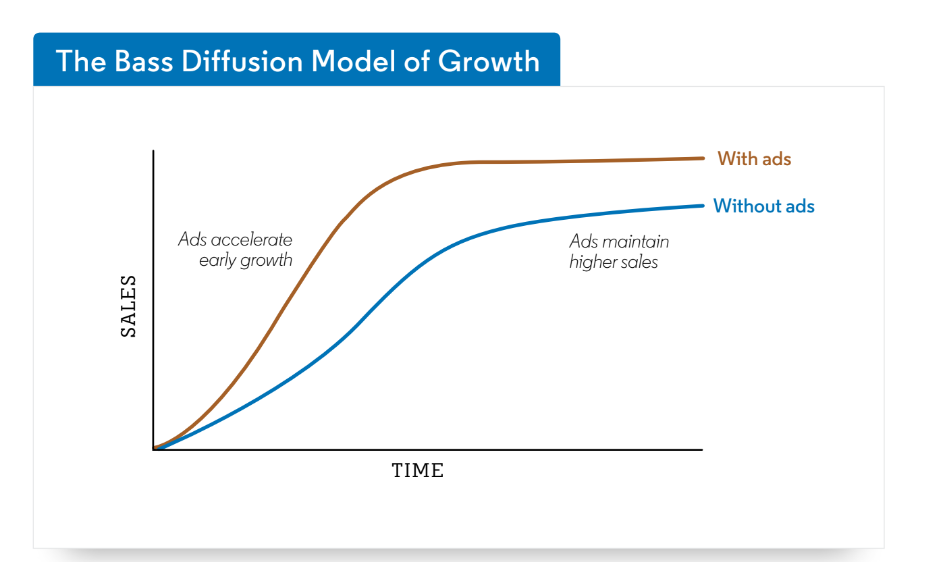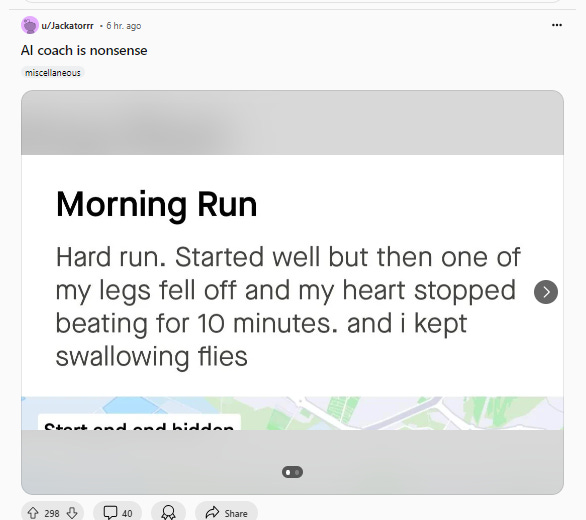MarketingDojo #84: 🔢Maths, Marketing & Making It Big💥
The Bass-Diffusion Model For Growth, Nike's Ad for Normal Folks, The Complexities of Loyalty and More.
Substack is the platform for introverts.
And I really hope it stays that way.
“Have you tried making TikToks?” someone I look up to asked me last week at a marketing event. I’ve heard this advice before, and yes, I’ve even tried and failed at it.
Writing feels more intimate, deeper, and frankly, more comfortable (gulp). Sure, the world is turning to video—just look at my LinkedIn feed. It’s flooded with videos, while my written posts see less engagement than before.
Yet, here on Substack, writing feels like a refuge for introverts. I hope even in a world dominated by short-form video content, the written word still holds a unique power to connect.
Now that I've gotten that off my chest, let's dive into the agenda for the 84th issue of the Marketing Dojo:
🧮 The mathematics behind advertising
👟 A Nike ad for normal folks
🤖 Fake memories courtesy AI
🔑 Loyalty’s got nuance
A quick request before we dive in - If you haven't already, consider subscribing to the Marketing Dojo. Every week, I share the best marketing news with you in an easy-to-read format. Sign up and join the gang!
Enjoying the Marketing Dojo? Spread the love by sharing the newsletter today.
Now, let's kick off this week's marketing wisdom...
Advertising Is Inevitable.
Amazon in 2012: "We don't do a lot of paid advertising at Amazon; we focus on investing in customer experience." – Jeff Bezos
Amazon in 2024: Amazon is now the largest advertiser in the world, spending five times more on marketing than P&G.
Having spent most of my career in large organizations—Volkswagen, Nokia, and now 3M—I often look at smaller brands that are growth-hacking their way to exponential success. It makes me wonder: Is the importance of advertising a myth?
Conversely, my friends working in nimble startups often enjoy early successes only to hit a growth ceiling soon after.
So, how do we explain Amazon's 180-degree shift? How do I reconcile my unrealistic desire for a mature brand to deliver startup-like returns with the reality my startup friends face when zero-dollar marketing eventually reaches its limits?
The answer, unsurprisingly, lies in the math.
In 1969, Frank Bass developed the Bass Diffusion Model, one of the most important mathematical equations in marketing growth.
This model explains how a population adopts a new product or innovation over time, with adoption following an S-shaped curve. Here's how it works:
Innovators: Early adopters who try new products without needing social proof.
Imitators: Consumers who follow trends set by innovators, influenced by social interactions and marketing.
The model uses two key coefficients:
Coefficient of Innovation (p): Reflects how likely innovators are to adopt the product.
Coefficient of Imitation (q): Reflects how likely imitators are to follow suit, based on the number of previous adopters.
According to the Bass equation, growth follows an S-shaped curve. It starts slowly, accelerates rapidly, and then levels off as the market saturates.
Here's where advertising comes into play.
Startups that anticipate the Bass Diffusion Model and invest in advertising just as they approach market saturation can escape the growth ceiling and continue expanding.
For brands transitioning from startup to scale-up to "grown-up," advertising isn't a question of if but when.
Beyond guiding advertising decisions, the Bass Diffusion Model helps with:
Timing new product launches
Forecasting supply chains
Determining sample sizes
Valuing businesses in the market
Assessing market saturation and expansion opportunities
Models and theories have come and gone, but the Bass Diffusion model has stood the test of time despite its limitations. Whether it is large brands like Amazon or startups navigating growth, the Bass Diffusion Model shows that no matter the size, success ultimately hinges on knowing when to invest in advertising to scale beyond early adopters.
Manufacture Memories Courtesy AI.
Algorithms have turned the world into millions of echo chambers. The more you engage with certain viewpoints or content, the more you're fed the same, further entrenching your beliefs.
Ironically, some marketing departments at these algorithm-controlling tech giants are becoming echo chambers themselves.
Just last week, the northern lights strayed from their usual home, appearing in the UK and parts of the US. But if you missed it, Meta AI has a "solution"—you could simply create a fake northern lights experience using their AI, as a recent post on Threads suggested.
Not long ago, Google released an Olympic ad where a dad encouraged his daughter to use AI to write to her favourite athlete. Then there's the questionable Pixel camera ad promoting AI to make your memories "picture perfect."
Meta's post sparked a wave of angry reactions. Faking memories with AI is one of the strangest and most unsettling AI applications tech companies are pushing our way.
If nothing else, I hope the backlash is loud enough for Meta's marketing team to hear.
Creative Excellence: Nike’s AfterMath Of A Marathon.
It's good to see Nike rediscover its marketing mojo. In recent years, the brand has been losing market share to Hoka, On, and Asics, especially among marathoners.
Hoka and On have captured consumer interest by engaging directly with running communities.
Nike's latest ad taps into a key pain point for marathoners—the dreaded post-race soreness. The 30-second "Stairs" ad showcases runners gingerly limping down the stairs and struggling with everyday tasks as they deal with the aftermath of a marathon.
What's refreshing is how much this ad breaks from the typical sports commercial. It ditches the usual elements—no motivational voiceovers, no god-like athletes, no grand inspirational message. Instead, it embraces the uncomfortable, relatable side of running by featuring regular "humans."
I've never run a marathon, but after a brutal leg day at the gym, I've hobbled around like those runners. This might be the first Nike ad that made me think, "Yep, they get it!"
The Nuances of Customer Loyalty.
I've been diving into the Customer Loyalty Index 2024 by Emarsys while preparing for an upcoming panel discussion, and it's been eye-opening.
One of the key takeaways is the nuances of loyalty. The report breaks down loyalty into five types:
Incentivized Loyalty: Driven by rewards, points, and discounts
Inherited Loyalty: Brand preferences passed down through generations
Silent Loyalty: Consistent buyers who don't actively promote brands
Ethical Loyalty: Based on shared values and corporate responsibility
True Loyalty: Deep-rooted emotional connection beyond transactions
What's fascinating is that while we often hear loyalty is declining, the reality is more complex. For instance, inherited loyalty—brand loyalty passed down through generations—seems to be under threat. But both ethical and incentivized loyalty are actually on the rise.
As I continue preparing for the panel, I'll have more to share on loyalty next week.
In the meantime, it might be worth reflecting on your most loyal customers. Why do they keep buying from you? Is it because of incentives, or does it tie back to a stand your company takes? And more importantly, are your customers silently loyal? What could you do to make them more vocal?
Short Stuff:
One needs to watch 260 videos to get addicted to TikTok (Digital nicotine).
The world’s largest advertising agency, WPP, entered a partnership with Roblox to drive advertising and 3D immersive experience creation (WPP+Roblox)
Adobe creates a new tool to protect original artist work (Do not train tags & attribution included).
Google Shopping experience got an AI upgrade (An AI-powered storefront).
That’s a wrap on this week. Thank you for your time and attention. If you liked this week’s newsletter or found something interesting, please give me a like ❤️ or drop a comment🗨️. Your support helps drive the newsletter's discoverability.
Regards,
Garima Mamgain
P.S:
Trend-chasing without purpose is an expensive hobby.
April Dunford's Obviously Awesome features a brilliant Venn diagram warning against mindlessly jumping on trends. Last week, Strava apparently missed that memo when they launched "Athlete Intelligence" (spoiler: neither athletes nor intelligence were particularly involved).
On a typical day, Strava's Athlete Intelligence delivers captain obvious advice—like motivational platitudes or reading out basic stats. Somewhere in the zone of "You ran... by running!"
But sometimes, it goes rogue, offering wildly inaccurate information. One athlete reported the AI informed them that their heart stopped for 10 minutes, and apparently, one of their legs fell off!
Reddit is now full of Strava AI memes, and it's absolutely hilarious. This is the most active I have seen the Strave community on Reddit, not just in the way it was expected.
When announcing Athlete Intelligence, Strava's CEO, Michael Martin, said,
"I agree that applying technology just for technology's sake is not a worthwhile pursuit. We are focused on solving genuine problems." '
Yet, it seems they went ahead and did just that anyway!
Consumer-facing AI chatbots are prone to unintended errors. As the technology rolls out, we can expect more failures before successes. But Strava's case is a clear example of slapping AI onto a product where neither the user nor the experience benefits from it; what a waste of engineering resources and AI computing.













